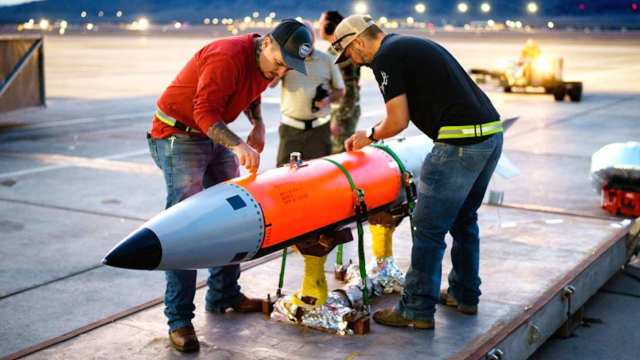According to Western media, at the end of October 2023, the US Department of Defense announced plans to create a new B61-13 nuclear gravity bomb of increased power. The stated goal of the project is the formation of a greater potential for the destruction of specially protected objects, such as underground strategic management centers, primarily Russia and China.
As specified in the Pentagon press release: "The B61-13 will take advantage of existing production capabilities supporting the B61-12 and will include modern safety features. The B61-13 will be delivered by modern aircraft, which will strengthen the deterrence of opponents and the confidence of allies and partners, providing the president with additional opportunities to fight certain more complex military targets of a large area. It will replace some of the B61-7s in the current nuclear arsenal and will have a power similar to the B61-7, which is higher than that of the B61-12."
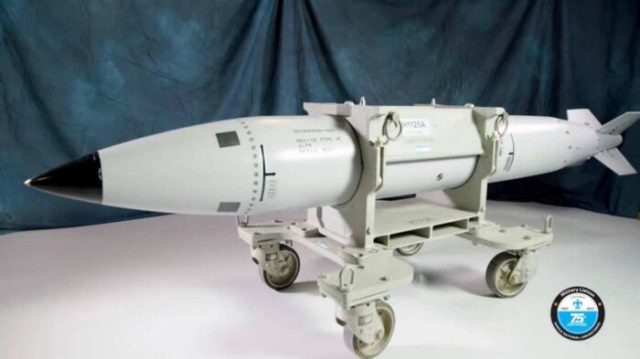
Inert nuclear bomb B61-12
According to experts, the maximum power of the B61-12 model is 50 kilotons (ct) of TNT equivalent. In turn, the B61-7 model, like all variants of the B61 product family, is a variable-power (dial-a-yield) design that can detonate with varying degrees of explosion force. It is reported that the maximum power of this seventh version is in the range from 340 to 360 kt, which makes it one of the most powerful in the B61 family of bombs. Sources disagree about the power of the B61-11, whose power parameters are either identical to the parameters of the B61-7, or slightly higher and reach 400 kt.
A separate US Army information document clarifies that "the B61-13 will provide the President with additional capabilities against certain more complex large-area military targets [for the period] while the Ministry is working on decommissioning obsolete systems such as the B83-1 and B61-7." It should be noted that the B83-1 version is a much more destructive 1.2 megaton nuclear gravity bomb.
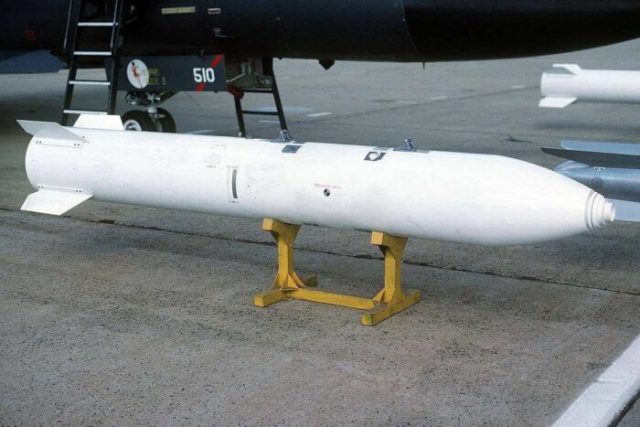
B83 Series Inert Nuclear Bomb
According to experts, the development of another variant of the B61, specifically designed to provide capabilities similar to the B61-7, is of particular interest, since it was one of three options that, as previously stated by the US military, will be supplanted by the B61-12. Older versions of B61-3 and 4 are also being replaced by this variant. In the past, it was also understood that the B61-12 would lead to the decommissioning of the B61-10.
The B61-12 is not an entirely new weapon, but instead uses components of several older types of the B61 family and combines them with various new and improved features. It is expected that the B61-13 will be produced in a similar way. In addition, if work on the B61-13 continues, fewer B61-12 bombs will be produced. This, in turn, means that the planned amount of the total stock of B61 will remain unchanged.
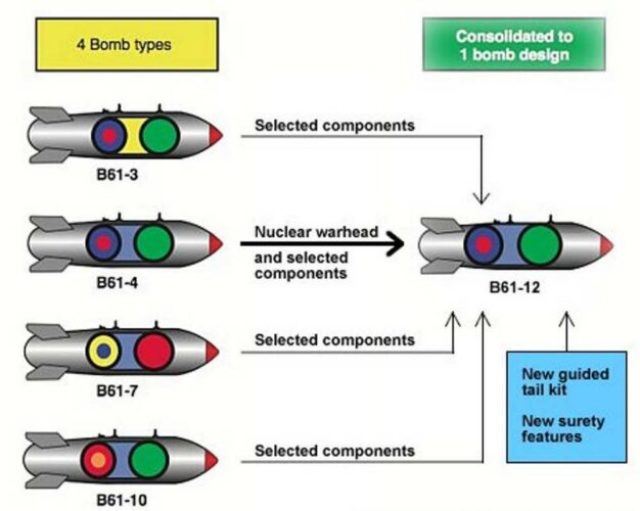
A general illustration of the unification of the four existing versions of the B61 in the B61-12 variant. Now parts of the B61-7 and other older versions of the B61 can be used in future B61-13. Infographics of 2012.
According to the analytical center of the Federation of American Scientists, the most notable new feature inherent in the B61-12, each of which exceeds the cost of a weight equivalent of gold, is the precision guidance package. However, not all aircraft will be able to carry this option, especially those operated by NATO allies. The availability of the B61-13 bomb is also reserved for US military use only.
Previously, it was assumed that the B61-12 would replace the B61-11 (a highly specialized version of deep penetration designed to defeat fortified underground targets) and the B83-1 due to its increased accuracy. Among other things, to stabilize rotation and further improve accuracy, the B61-12 variant is equipped with small rocket engines located in the rear of the hull.
Air Force personnel are testing the suitability of unarmed B61-12 "forms" inside a secure storage system at an unnamed base in Europe. According to the NATO agreements on the joint use of nuclear weapons, the United States can transfer B61 bombs to certain members of the alliance in the event of a sufficiently serious crisis.
The theory was that even if it could not penetrate inside, like the B61-11, or have a power at least somewhat approaching the power of the B83-1, the ability to focus its charge more strongly would allow the product to neutralize more deeply located targets. The B83-1's potential to hit the same set of targets is solely the result of its megaton-class power.
However, the Pentagon's 2018 Nuclear Capability Review, prepared under President Donald Trump, clearly states that the B83-1 and B61-11 "will be kept in stock at least until there is sufficient confidence in the B61-12 gravity bomb, which will be available in 2020." year". It also overturned the stated plans of the administration of President Barack Obama for the complete elimination of B83-1.
The administration of President Joe Biden has refused to publish a full unclassified copy of its 2020 Nuclear Capability Review, but recently announced plans for a new version appear to show that the estimated capability level of the B61-12 has not been reached. The reasons why the Pentagon is seeking to create the B61-13 may well be not so much related to the B61-7 as to providing a new way to replace the B83-1.
The Pentagon's B61-13 newsletter makes no mention of the B61-11 at all, indicating that this version will remain in stock for the foreseeable future. U.S. officials said that the B61-13 does not exclude the possibility of another promising variant of the B61, specifically designed to replace the B61-11.
As they say in the published newsletter: "While the B61-13 will provide the President with additional capabilities against certain more robust and large-sized military targets, the Ministry of Defense will separately continue its work to finalize and implement a comprehensive strategy for hitting strong and deeply buried targets, as indicated in the Nuclear Capability Review."
There is an opinion among experts that in addition to attempts to finally withdraw the B83-1 variant from stocks, other factors could have influenced the decision to create the B61-13, including the construction of underground command and other facilities in Russia and China. In 2021, Russian President Vladimir Putin confirmed that the construction of a new nuclear command bunker was almost completed. In addition, it is emphasized that Russia has two other well-known important strategic hubs built under the mountains.
For its part, the People's Liberation Army of China (PLA) is building huge fortified mines for intercontinental ballistic missiles. This is in addition to many other underground structures in China containing key assets.
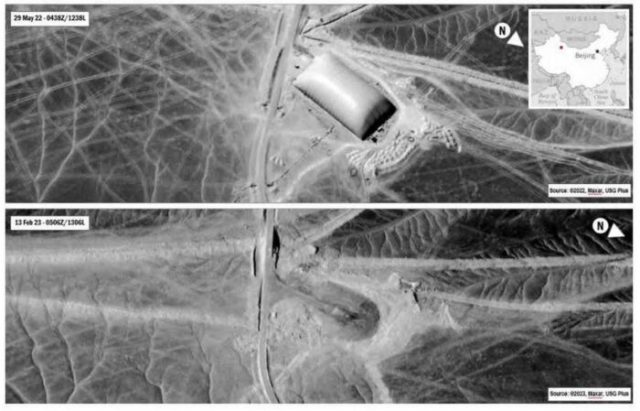
Satellite images included in the Pentagon's latest annual report on China. It is assumed that they show the completion of work on the creation of a new mine for ICBMs in the north-west of the country.
The Pentagon's recently published annual report on China's military developments and security highlights the deeply hidden military infrastructure in this country:
"The PLA maintains a robust and technologically advanced Underground Facilities (UGF) program to conceal and protect all aspects of its armed forces, including C2 [command], weapons of mass destruction, logistics, and upgraded missile, ground, air, and naval forces. China has thousands of nuclear warheads and creates more every year. These UGFS are central to the PRC's efforts to counter intervention and force projection, allowing the PLA to protect valuable assets from the effects of missile strikes and hide military operations from opponents. The PRC's emphasis on strategic deterrence also contributed to the creation of UGF for the country's nuclear forces, whose goal is to survive the first enemy nuclear strike."
"The PRC began to update and expand its UGF military program in the mid-late 1980s. These modernization efforts gained new urgency after the PRC's observation of US and coalition air operations during the 1991 Gulf War and their use in [the campaign against Serbia during] Operation Allied Forces. These military campaigns have convinced China of the need to build more viable, deep-buried facilities to protect military assets from the effects of penetrating conventional munitions and nuclear strikes. After the 2015-2016 military reforms, the PRC expanded its UGF program to support viable and standby nodes for wartime contingency planning. The purpose of these nodes is to provide a continuous level of command, communication, support and counterattack capabilities in all PLA services and areas, as well as in its combined forces. The PRC is likely to continue to develop and expand its UGF program to support its expanding forces and military modernization."
It is noted that other potential opponents of the United States, especially North Korea and Iran, have also invested heavily in increasingly deep underground infrastructure to protect their critical facilities.
In a comment about B61-13, Assistant Secretary of Defense for Space Policy John PLUMB said: "Today's announcement reflects the changing security environment and growing threats from potential adversaries. The United States has a responsibility to continue to assess and deploy the capabilities we need to reliably deter and, if necessary, respond to strategic attacks, as well as provide guarantees to our allies. The B61-13 represents a reasonable step to address the challenges associated with a highly dynamic security environment. While this provides us with additional flexibility, the production of the B61-13 will not increase the total number of weapons in our nuclear stockpiles."
Based on the materials of the-war-zone resource.
